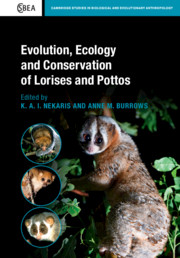Book contents
- Evolution, Ecology and Conservation of Lorises and Pottos
- Cambridge Studies in Biological and Evolutionary Anthropology
- Evolution, Ecology and Conservation of Lorises and Pottos
- Copyright page
- Dedication
- Contents
- Contributors
- Foreword
- Acknowledgements
- 1 Introduction
- Part I Evolution, Morphology and the Fossil Record
- 2 Sluggards and Drunkards?
- 3 What We Know (and Don’t Know) About the Fossil Records of Lorisids
- 4 Outliers
- 5 Molecular Advances in Lorisid Taxonomy and Phylogeny
- 6 The Toothcomb of Karanisia clarki
- 7 The Soft-Tissue Anatomy of the Highly Derived Hand of Perodicticus Relative to the More Generalised Nycticebus
- 8 Making Scents of Olfactory Sensitivity in Lorises and Pottos
- 9 Allometric and Phylogenetic Diversity in Lorisiform Orbit Orientation
- 10 The Evolution of Social Organisation in Lorisiformes
- 11 Biomechanics of Loris Locomotion
- 12 What Role Did Gum-Feeding Play in the Evolution of the Lorises?
- Part II Ecology and Captive Management
- Part III Research, Trade and Conservation
- References
- Index
12 - What Role Did Gum-Feeding Play in the Evolution of the Lorises?
from Part I - Evolution, Morphology and the Fossil Record
Published online by Cambridge University Press: 29 February 2020
- Evolution, Ecology and Conservation of Lorises and Pottos
- Cambridge Studies in Biological and Evolutionary Anthropology
- Evolution, Ecology and Conservation of Lorises and Pottos
- Copyright page
- Dedication
- Contents
- Contributors
- Foreword
- Acknowledgements
- 1 Introduction
- Part I Evolution, Morphology and the Fossil Record
- 2 Sluggards and Drunkards?
- 3 What We Know (and Don’t Know) About the Fossil Records of Lorisids
- 4 Outliers
- 5 Molecular Advances in Lorisid Taxonomy and Phylogeny
- 6 The Toothcomb of Karanisia clarki
- 7 The Soft-Tissue Anatomy of the Highly Derived Hand of Perodicticus Relative to the More Generalised Nycticebus
- 8 Making Scents of Olfactory Sensitivity in Lorises and Pottos
- 9 Allometric and Phylogenetic Diversity in Lorisiform Orbit Orientation
- 10 The Evolution of Social Organisation in Lorisiformes
- 11 Biomechanics of Loris Locomotion
- 12 What Role Did Gum-Feeding Play in the Evolution of the Lorises?
- Part II Ecology and Captive Management
- Part III Research, Trade and Conservation
- References
- Index
Summary
The first primate-like mammals to appear in the fossil record date to the earliest Palaeocene (Clemens, 2004; Fox and Scott, 2011; Silcox and López-Torres, 2017; Van Valen and Sloan, 1965), and the first primates of modern aspect (euprimates) do not appear until the latest Palaeocene/earliest Eocene (Morse et al., 2019; Ni et al., 2013; Rose et al., 2012; Sigé et al., 1990; Silcox et al., 2017; Smith et al., 2006). However, the most recent molecular estimates for the last common ancestor (LCA) of all living primates suggest that the order originated at some point between the late Cretaceous and the early Palaeocene (approximately between 60 and 70 Mya; Andrews et al., 2016; Herrera and Dávalos, 2016; Seiffert et al., 2018). Later, between 42 and 55 Mya (according to the same sources for molecular dates), Strepsirrhini split into the progenitors of the infraorders Lemuriformes and Lorisiformes (throughout this chapter we use the taxonomy established by Grubb et al., 2003). The Lemuriformes went on to radiate into the vast array of morphologically diverse living and extinct lemurs located on the island of Madagascar, and the lorisiforms split into two families: Lorisidae (pottos, angwantibos, slender lorises and slow lorises) and Galagidae, the bushbabies (Covert, 2002; Martin, 1990; Rasmussen and Nekaris, 1998).
- Type
- Chapter
- Information
- Evolution, Ecology and Conservation of Lorises and Pottos , pp. 153 - 162Publisher: Cambridge University PressPrint publication year: 2020
- 5
- Cited by



